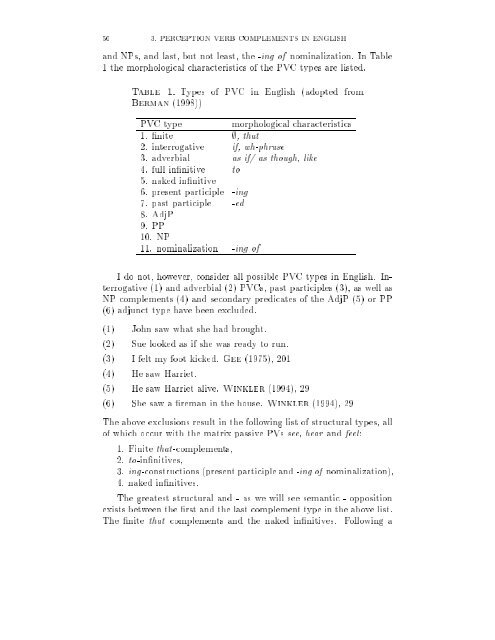Perception verb complements in Akatek, a Mayan language
Perception verb complements in Akatek, a Mayan language
Perception verb complements in Akatek, a Mayan language
Create successful ePaper yourself
Turn your PDF publications into a flip-book with our unique Google optimized e-Paper software.
50 3. PERCEPTION VERB COMPLEMENTS IN ENGLISH<br />
and NPs, and last, but not least, the -<strong>in</strong>g of nom<strong>in</strong>alization. In Table<br />
1 the morphological characteristics of the PVC types are listed.<br />
Table 1. Types of PVC <strong>in</strong> English (adopted from<br />
Berman (1998))<br />
PVC type morphological characteristics<br />
1. nite ;, that<br />
2. <strong>in</strong>terrogative if, wh-phrase<br />
3. ad<strong>verb</strong>ial as if/ as though, like<br />
4. full <strong>in</strong> nitive to<br />
5. naked <strong>in</strong> nitive<br />
6. present participle -<strong>in</strong>g<br />
7. past participle -ed<br />
8. AdjP<br />
9. PP<br />
10. NP<br />
11. nom<strong>in</strong>alization -<strong>in</strong>g of<br />
I do not, however, consider all possible PVC types <strong>in</strong> English. Interrogative<br />
(1) and ad<strong>verb</strong>ial (2) PVCs, past participles (3), as well as<br />
NP <strong>complements</strong> (4) and secondary predicates of the AdjP (5) or PP<br />
(6) adjunct type have been excluded.<br />
(1) John saw what she had brought.<br />
(2) Sue looked as if she was ready to run.<br />
(3) I felt my foot kicked. Gee (1975), 201<br />
(4) He saw Harriet.<br />
(5) He saw Harriet alive. W<strong>in</strong>kler (1994), 29<br />
(6) She saw a reman <strong>in</strong> the house. W<strong>in</strong>kler (1994), 29<br />
The above exclusions result <strong>in</strong> the follow<strong>in</strong>g list of structural types, all<br />
of which occur with the matrix passive PVs see, hear and feel:<br />
1. F<strong>in</strong>ite that-<strong>complements</strong>,<br />
2. to-<strong>in</strong> nitives,<br />
3. <strong>in</strong>g-constructions (present participle and -<strong>in</strong>g of nom<strong>in</strong>alization),<br />
4. naked <strong>in</strong> nitives.<br />
The greatest structural and - as we will see semantic - opposition<br />
exists between the rst and the last complementtype <strong>in</strong> the above list.<br />
The nite that <strong>complements</strong> and the naked <strong>in</strong> nitives. Follow<strong>in</strong>g a

















